Synthesis of MRGO Nanocomposites as a Potential Photocatalytic Demulsifier for Crude Oil-in-Water Emulsion
Abstract
:1. Introduction
2. Materials and Methods
2.1. Material
2.2. Synthesis of GO
2.3. Synthesis of MRGO Nanocomposites
2.4. Preparation O/W Emulsion
2.5. Characterization of MRGOs
2.6. Demulsification Test
3. Results and Discussion
3.1. XRD Analysis
3.2. FESEM Analysis
3.3. Raman Analysis
3.4. FTIR Analysis
3.5. XPS Analysis
3.6. VSM Analysis
3.7. Demulsification Mechanism
4. Conclusions
Author Contributions
Funding
Conflicts of Interest
References
- Roodbari, N.H.; Badiei, A.; Soleimani, E.; Khaniani, Y. Tweens demulsification effects on heavy crude oil/water emulsion. Arab. J. Chem. 2016, 9, S806–S811. [Google Scholar] [CrossRef] [Green Version]
- Zolfaghari, R.; Fakhru’l-Razi, A.; Abdullah, L.C.; Elnashaie, S.S.E.H.; Pendashteh, A. Demulsification techniques of water-in-oil and oil-in-water emulsions in petroleum industry. Sep. Purif. Technol. 2016. [Google Scholar] [CrossRef]
- Ahmed, S.N.; Haider, W. Heterogeneous photocatalysis and its potential applications in water and wastewater treatment: A review. Nanotechnology 2018, 29. [Google Scholar] [CrossRef] [Green Version]
- Bagheri, S.; Julkapli, N.M. Magnetite hybrid photocatalysis: Advance environmental remediation. Rev. Inorg. Chem. 2016, 36, 135–151. [Google Scholar] [CrossRef]
- Liu, J.; Li, X.; Jia, W.; Li, Z.; Zhao, Y.; Ren, S. Demulsification of Crude Oil-in-Water Emulsions Driven by Graphene Oxide Nanosheets. Energy Fuels 2015, 29, 4644–4653. [Google Scholar] [CrossRef] [Green Version]
- Reza, K.M.; Kurny, A.; Gulshan, F. Photocatalytic Degradation of Methylene Blue by Magnetite+H2O2+UV Process. Int. J. Environ. Sci. Dev. 2016, 7, 325–329. [Google Scholar] [CrossRef] [Green Version]
- MArefi; Saberi, D.; Karimi, M.; Heydari, A. Superparamagnetic Fe(OH)3@Fe3O4 nanoparticles: An efficient and recoverable catalyst for tandem oxidative amidation of alcohols with amine hydrochloride salts. ACS Comb. Sci. 2015, 17, 341–347. [Google Scholar] [CrossRef]
- Wai, M.M.; Khe, C.S.; Yau, X.H.; Liu, W.W.; Sokkalingam, R.; Jumbri, K.; Lwin, N. Optimization and characterization of magnetite-reduced graphene oxide nanocomposites for demulsification of crude oil in water emulsion. RSC Adv. 2019, 9, 24003–24014. [Google Scholar] [CrossRef] [Green Version]
- Yau, X.H. Synthesis of Magnetite-Reduced Graphene Oxide Nanocomposite as a Recyclable Demulsifier for Crude Oil-In-Water Emulsion. Master’s Thesis, University Teknologi Petronus, Perak, Malaysia, 2019. [Google Scholar]
- Yau, X.H.; Khe, C.S.; Saheed, M.S.M.; Lai, C.W.; You, K.Y.; Tan, W.K. Magnetically recoverable magnetite-reduced graphene oxide as a demulsifier for surfactant stabilized crude oil-in-water emulsion. PLoS ONE 2020, 15. [Google Scholar] [CrossRef] [PubMed]
- Orimolade, B.O.; Adekola, F.A.; Adebayo, G.B. Adsorptive removal of bisphenol A using synthesized magnetite nanoparticles. Appl. Water Sci. 2018, 8, 1–8. [Google Scholar] [CrossRef] [Green Version]
- Feng, X.; Lou, X. The effect of surfactants-bound magnetite (Fe3O4) on the photocatalytic properties of the heterogeneous magnetic zinc oxides nanoparticles. Sep. Purif. Technol. 2015, 147, 266–275. [Google Scholar] [CrossRef] [Green Version]
- Huong, P.T.L.; Huyen, N.T.; Giang, C.D.; Tu, N.; Phan, V.N.; Van Quy, N.; Huy, T.Q.; Hue, D.T.M.; Chinh, H.D.; Le, A.-T. Facile synthesis and excellent adsorption property of GO-Fe3O4 magnetic nanohybrids for removal of organic dyes. J. Nanosci. Nanotechnol. 2016, 16, 9544–9556. [Google Scholar] [CrossRef]
- Li, J.; Östling, M. Prevention of graphene restacking for performance boost of supercapacitors-a review. Crystals 2013, 3, 163–190. [Google Scholar] [CrossRef]
- Guo, J.; Jiang, B.; Zhang, X.; Zhou, X.; Hou, W. Fe2.25W0.75O4/reduced graphene oxide nanocomposites for novel bifunctional photocatalyst: One-pot synthesis, magnetically recyclable and enhanced photocatalytic property. J. Solid State Chem. 2013, 205, 171–176. [Google Scholar] [CrossRef]
- Boruah, P.K.; Sharma, B.; Karbhal, I.; Shelke, M.V.; Das, M.R. Ammonia-modified graphene sheets decorated with magnetic Fe3O4 nanoparticles for the photocatalytic and photo-Fenton degradation of phenolic compounds under sunlight irradiation. J. Hazard. Mater. 2017, 325, 90–100. [Google Scholar] [CrossRef] [PubMed]
- Sponza, D.T.; Alicanoglu, P. Reuse and recovery of raw hospital wastewater containing ofloxacin after photocatalytic treatment with nano graphene oxide magnetite. Water Sci. Technol. 2018, 77, 304–322. [Google Scholar] [CrossRef]
- Ma, S.; Wang, Y.; Wang, X.; Li, Q.; Tong, S.; Han, X. Bifunctional Demulsifier of ODTS Modified Magnetite/Reduced Graphene Oxide Nanocomposites for Oil–water Separation. ChemistrySelect 2016, 1, 4742–4746. [Google Scholar] [CrossRef]
- Wang, B.; Gu, D.; Ji, L.; Wu, H. Photocatalysis: A novel approach to efficient demulsification. Catal. Commun. 2016, 75, 83–86. [Google Scholar] [CrossRef] [Green Version]
- Teo, P.S.; Lim, H.N.; Huang, N.M.; Chia, C.H.; Harrison, I. Room temperature in situ chemical synthesis of Fe3O4/graphene. Ceram. Int. 2012, 38, 6411–6416. [Google Scholar] [CrossRef]
- Chia, C.H. Fabrication and characterization of graphene hydrogel via hydrothermal approach as a scaffold for preliminary study of cell growth. Int. J. Nanomed. 2011, 6, 1817–1823. [Google Scholar]
- Di Iorio, E.; Colombo, C.; Cheng, Z.; Capitani, G.; Mele, D.; Ventruti, G.; Angelico, R. Characterization of magnetite nanoparticles synthetized from Fe(II)/nitrate solutions for arsenic removal from water. J. Environ. Chem. Eng. 2019, 7, 102986. [Google Scholar] [CrossRef]
- Xu, C.; Wang, X.; Zhu, J. Graphene-Metal particle nanocomposites. J. Phys. Chem. C 2008, 112, 19841–19845. [Google Scholar] [CrossRef]
- Peik-See, T.; Pandikumar, A.; Ngee, L.H.; Ming, H.N.; Hua, C.C. Magnetically separable reduced graphene oxide/iron oxide nanocomposite materials for environmental remediation. Catal. Sci. Technol. 2014, 4, 4396–4405. [Google Scholar] [CrossRef] [Green Version]
- Hidayah, N.M.S.; Liu, W.-W.; Lai, C.-W.; Noriman, N.Z.; Khe, C.-S.; Hashim, U.; Lee, H.C. Comparison on graphite, graphene oxide and reduced graphene oxide: Synthesis and characterization. AIP Conf. Proc. 2017, 1892. [Google Scholar] [CrossRef]
- Moztahida, M.; Jang, J.; Nawaz, M.; Lim, S.R.; Lee, D.S. Effect of rGO loading on Fe3O4: A visible light assisted catalyst material for carbamazepine degradation. Sci. Total Environ. 2019, 667, 741–750. [Google Scholar] [CrossRef] [PubMed]
- Wu, J.B.; Lin, M.L.; Cong, X.; Liu, H.N.; Tan, P.H. Raman spectroscopy of graphene-based materials and its applications in related devices. Chem. Soc. Rev. 2018, 47, 1822–1873. [Google Scholar] [CrossRef] [Green Version]
- Shebanova, O.N.; Lazor, P. Raman spectroscopic study of magnetite (FeFe2O4): A new assignment for the vibrational spectrum. J. Solid State Chem. 2003, 174, 424–430. [Google Scholar] [CrossRef]
- Slavov, L.; Abrashev, M.; Merodiiska, T.; Gelev, C.; Vandenberghe, R.; Markova-Deneva, I.; Nedkov, I. Raman spectroscopy investigation of magnetite nanoparticles in ferrofluids. J. Magn. Magn. Mater. 2010, 322, 1904–1911. [Google Scholar] [CrossRef] [Green Version]
- Andrijanto, E.; Shoelarta, S.; Subiyanto, G.; Rifki, S. Facile synthesis of graphene from graphite using ascorbic acid as reducing agent. AIP Conf. Proc. 2016, 1725. [Google Scholar] [CrossRef] [Green Version]
- Zhou, Z.; Su, M.; Shih, K. Highly efficient and recyclable graphene oxide-magnetite composites for isatin mineralization. J. Alloy. Compd. 2017, 725, 302–309. [Google Scholar] [CrossRef]
- Akbarzadeh, A.; Samiei, M.; Joo, S.W.; Anzaby, M.; Hanifehpour, Y. RETRACTED ARTICLE: Synthesis, characterization and in vitro studies of doxorubicin-loaded magnetic nanoparticles grafted to smart copolymers on A549 lung cancer cell line. J. Nanobiotechnol. 2012, 1–13. [Google Scholar] [CrossRef] [Green Version]
- Yamashita, T.; Hayes, P. Analysis of XPS spectra of Fe2+ and Fe3+ ions in oxide materials. Appl. Surf. Sci. 2008, 254, 2441–2449. [Google Scholar] [CrossRef]
- Muzyka, R.; Drewniak, S.; Pustelny, T.; Chrubasik, M.; Gryglewicz, G. Characterization of graphite oxide and reduced graphene oxide obtained from different graphite precursors and oxidized by different methods using Raman spectroscopy. Materials 2018, 11, 1050. [Google Scholar] [CrossRef] [PubMed] [Green Version]
- Al-Gaashani, R.; Najjar, A.; Zakaria, Y.; Mansour, S.; Atieh, M.A. XPS and structural studies of high quality graphene oxide and reduced graphene oxide prepared by different chemical oxidation methods. Ceram. Int. 2019, 45, 14439–14448. [Google Scholar] [CrossRef]
- Xu, C.; Shi, X.; Ji, A.; Shi, L.; Zhou, C.; Cui, Y. Fabrication and characteristics of reduced graphene oxide produced with different green reductants. PLoS ONE 2015, 10. [Google Scholar] [CrossRef] [Green Version]
- Lu, A.H.; Salabas, E.L.; Schüth, F. Magnetic nanoparticles: Synthesis, protection, functionalization, and application. Angew. Chem. Int. Ed. 2007, 46, 1222–1244. [Google Scholar] [CrossRef]
- Pang, F.; Zhang, R.; Lan, D.; Ge, J. Synthesis of Magnetite-Semiconductor-Metal Trimer Nanoparticles through Functional Modular Assembly: A Magnetically Separable Photocatalyst with Photothermic Enhancement for Water Reduction. ACS Appl. Mater. Interfaces 2018, 10, 4929–4936. [Google Scholar] [CrossRef] [PubMed]
- Wang, X.; Tian, H.; Yang, Y.; Wang, H.; Wang, S.; Zheng, W.; Liu, Y. Reduced graphene oxide/CdS for efficiently photocatalystic degradation of methylene blue. J. Alloy. Compd. 2012, 524, 5–12. [Google Scholar] [CrossRef]
- Jiang, X.; Li, L.; Cui, Y.; Cui, F. New branch on old tree: Green-synthesized RGO/Fe3O4 composite as a photo-Fenton catalyst for rapid decomposition of methylene blue. Ceram. Int. 2017, 43, 14361–14368. [Google Scholar] [CrossRef]
- Liu, W.; Qian, J.; Wang, K.; Xu, H.; Jiang, D.; Liu, Q.; Yang, X.; Li, H. Magnetically Separable Fe3O4 Nanoparticles-Decorated Reduced Graphene Oxide Nanocomposite for Catalytic Wet Hydrogen Peroxide Oxidation. J. Inorg. Organomet. Polym. Mater. 2013, 23, 907–916. [Google Scholar] [CrossRef]
- Mahapatra, P.; Giri, S.K.; Das, N. Adsorptive and photocatalytic remediation of aqueous organic dyes and chromium(VI) by manganese(II) substituted magnetite nanoparticles. Desalin. Water Treat. 2019, 141, 208–219. [Google Scholar] [CrossRef]
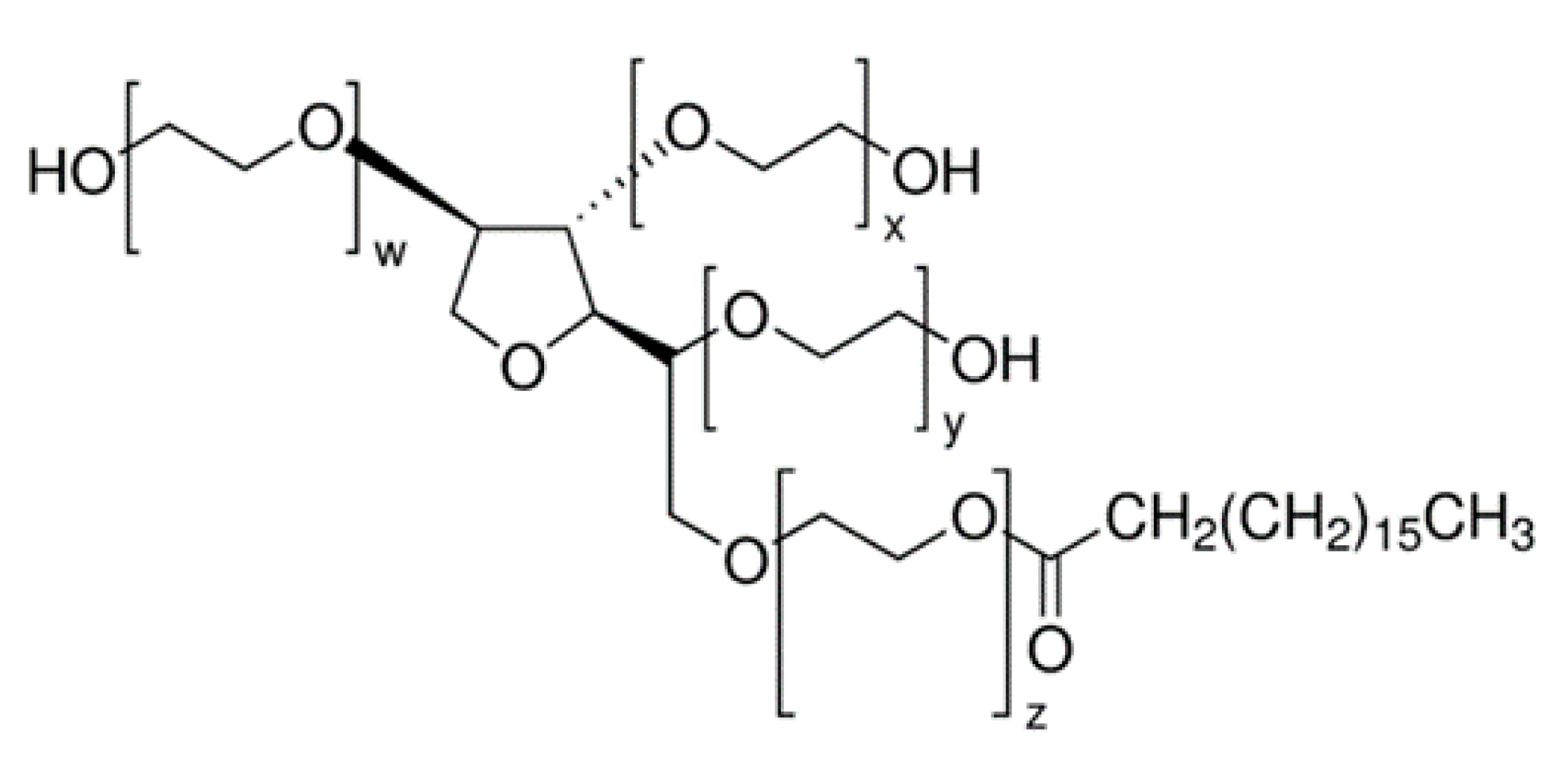
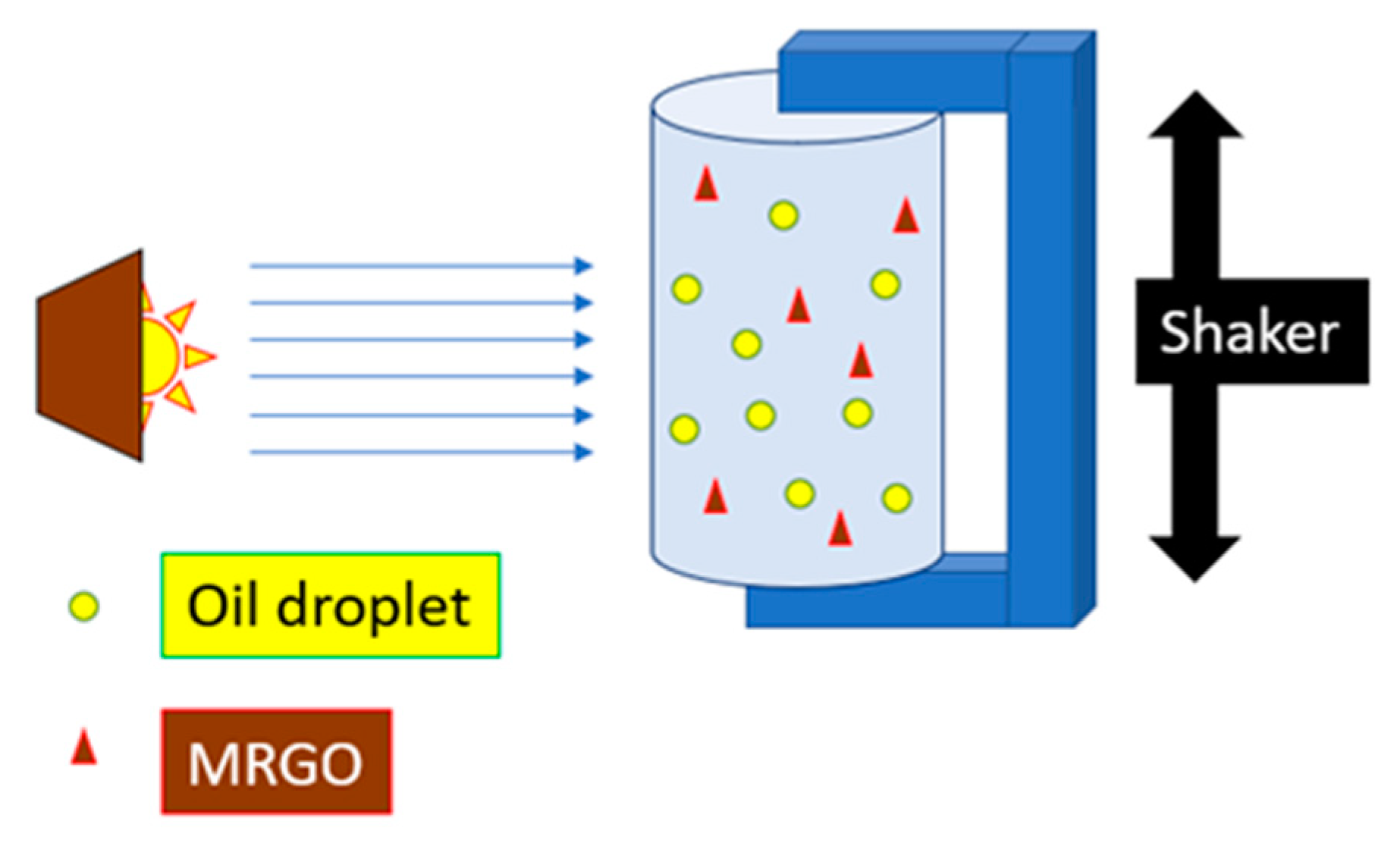





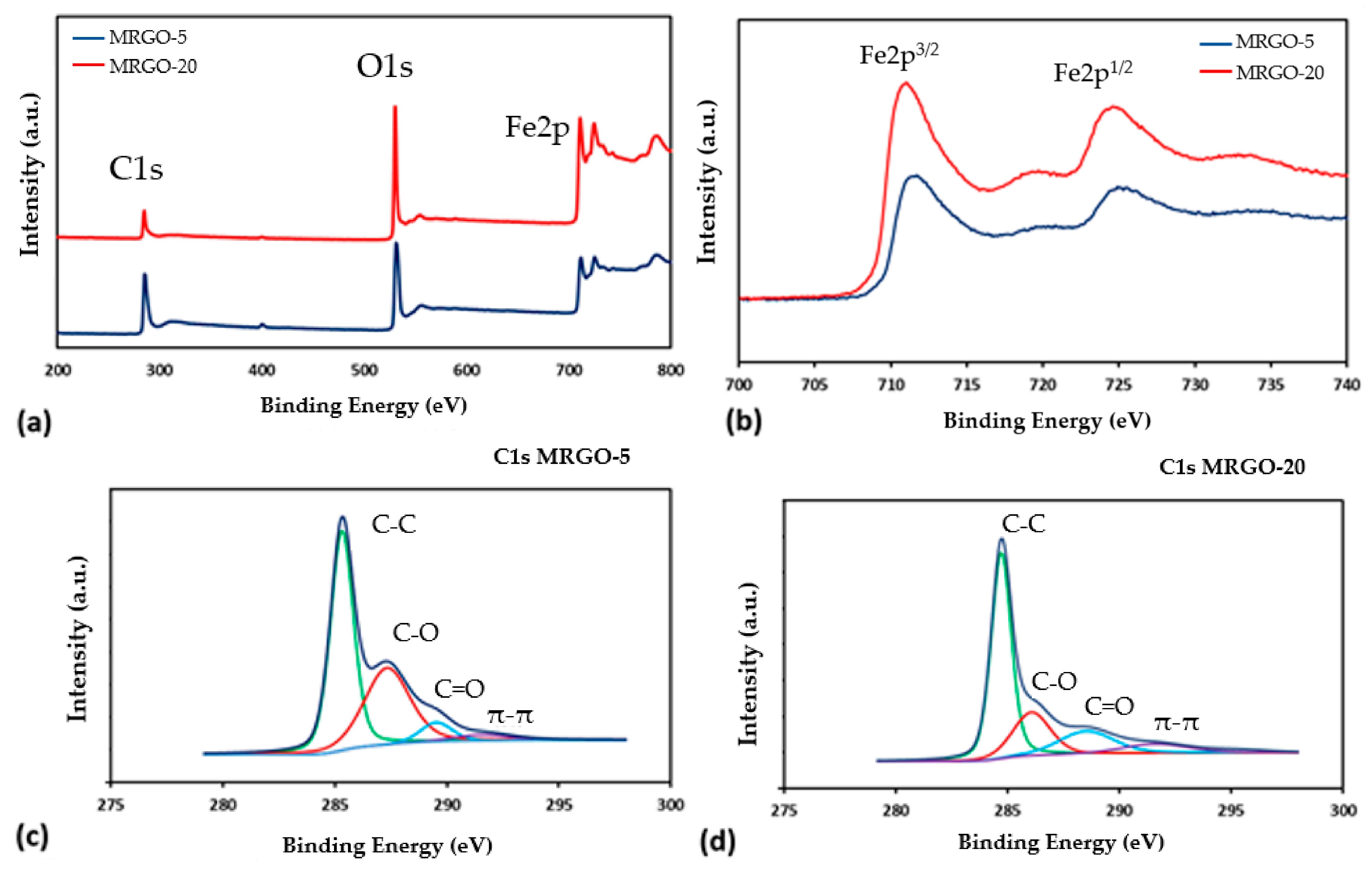


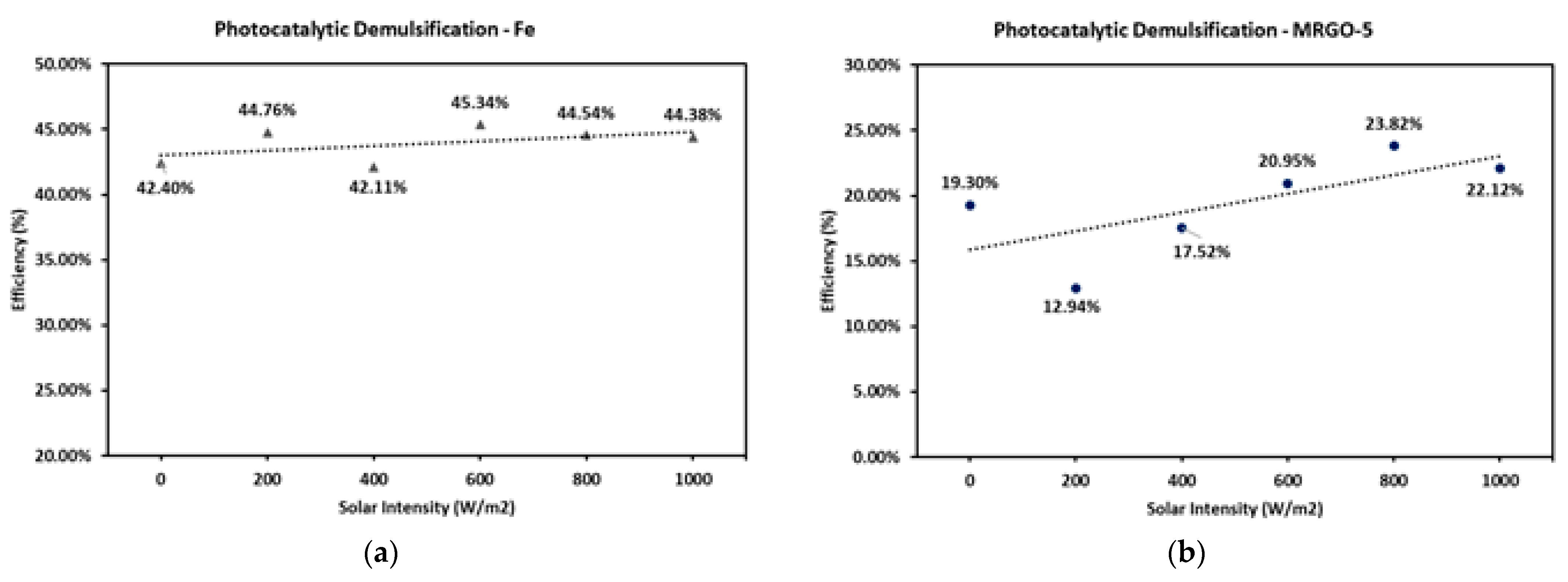
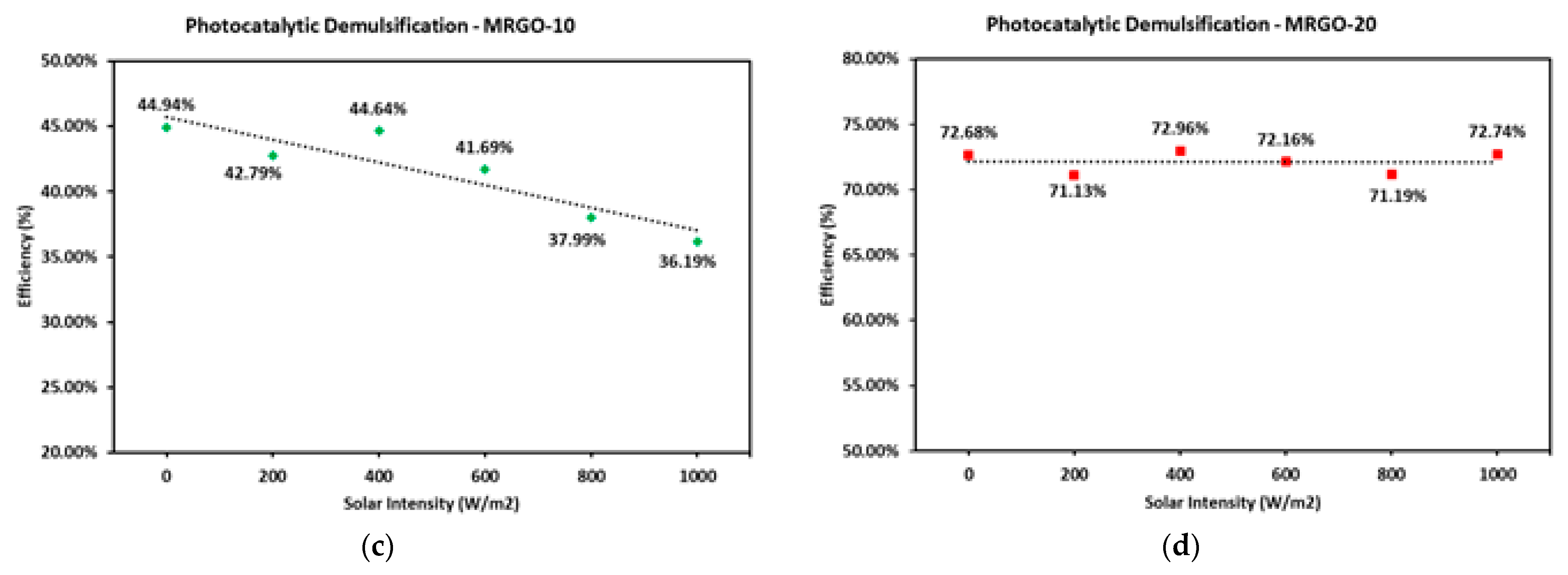
| Parameter | Value |
|---|---|
| Density | 0.827 g cm−3 |
| Viscosity | 0.028 Pa s |
| API gravity | 43.0 |
| Surface Tension (at 30 °C) | 30.30 mN m−1 |
| Interfacial Tension (at 30 °C) | 28.80 mN m−1 |
| Parameter | Value (wt%) |
|---|---|
| Saturates | 60.00 |
| Aromatics | 25.00 |
| Resins | 13.50 |
| Asphaltenes | 1.50 |
| Element | Weight (%) | Atomic (%) | Atomic Ratio (Fe/c) | |
|---|---|---|---|---|
| GO | C | 50.34 | 57.45 | |
| O | 49.66 | 42.55 | ||
| MRGO-5 | C | 23.27 | 38.77 | |
| O | 37.47 | 46.90 | 0.37 | |
| Fe | 39.26 | 14.33 | ||
| MRGO-10 | C | 14.12 | 26.29 | |
| O | 39.42 | 55.07 | 0.71 | |
| Fe | 46.47 | 18.64 | ||
| MRGO-20 | C | 9.74 | 20.85 | |
| O | 32.75 | 52.65 | 1.27 | |
| Fe | 57.51 | 26.50 |
| ID/IG | GO | MRGO-5 | MRGO-10 | MRGO-20 |
| 0.9625 | 1.0077 | 1.0181 | 1.0193 |
| Peak Value (cm−1) | Functional Groups | GO | MrGO |
|---|---|---|---|
| 3400 | Hydroxyl-OH | Yes | Yes |
| 1577 | Aromatic C=C stretching | Yes | N/A |
| 1218 | Epoxy C-O | Yes | Yes |
| 1074 | Anhydride group CO-O-CO | Yes | N/A |
| 618 | Fe-O | N/A | Yes |
| 560 | Fe-O/OH out-of-plane bending | OH out-of-plane bend | Fe-O |
Publisher’s Note: MDPI stays neutral with regard to jurisdictional claims in published maps and institutional affiliations. |
© 2021 by the authors. Licensee MDPI, Basel, Switzerland. This article is an open access article distributed under the terms and conditions of the Creative Commons Attribution (CC BY) license (https://creativecommons.org/licenses/by/4.0/).
Share and Cite
Lau, Z.Y.; Tan, K.S.; Khe, C.S.; Lai, C.W.; You, K.Y.; Tan, W.K. Synthesis of MRGO Nanocomposites as a Potential Photocatalytic Demulsifier for Crude Oil-in-Water Emulsion. J. Compos. Sci. 2021, 5, 174. https://doi.org/10.3390/jcs5070174
Lau ZY, Tan KS, Khe CS, Lai CW, You KY, Tan WK. Synthesis of MRGO Nanocomposites as a Potential Photocatalytic Demulsifier for Crude Oil-in-Water Emulsion. Journal of Composites Science. 2021; 5(7):174. https://doi.org/10.3390/jcs5070174
Chicago/Turabian StyleLau, Zhen Yin, Ko Shyn Tan, Cheng Seong Khe, Chin Wei Lai, Kok Yeow You, and Wai Kian Tan. 2021. "Synthesis of MRGO Nanocomposites as a Potential Photocatalytic Demulsifier for Crude Oil-in-Water Emulsion" Journal of Composites Science 5, no. 7: 174. https://doi.org/10.3390/jcs5070174
APA StyleLau, Z. Y., Tan, K. S., Khe, C. S., Lai, C. W., You, K. Y., & Tan, W. K. (2021). Synthesis of MRGO Nanocomposites as a Potential Photocatalytic Demulsifier for Crude Oil-in-Water Emulsion. Journal of Composites Science, 5(7), 174. https://doi.org/10.3390/jcs5070174







